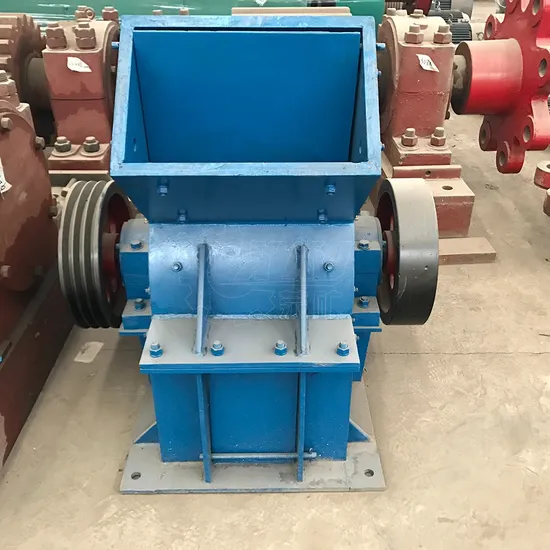
Portable Wood Stone Gold Crusher Machine Hammer Mill Metal Crusher
| US$1,400.00 | 1 Piece (MOQ) |
Basic Info.
Cutter Material
High-Speed Steel
Drive
Electric
Object
Coal, Metal, Plastic, Wood
Type
Hammer Crusher
MOQ
1 Set
After-Sales Service Provided
Engineers
Raw Material
Stones Rocks Ores
Features
High Processing Capacity
Service
on-Site Support
Price
Negotiatable
Spare Parts Supply
Anytime
Quality
Advanced Technology
Motor
Chinese Famous Brand
Product Type
Aggregate Crushing Equipment
Transport Package
Wooden
Specification
812*982*785
Trademark
XKJ
Origin
Henan
Production Capacity
8 T/H
Packaging & Delivery
Package Size
912.00cm * 1082.00cm * 1100.00cm
Package Gross Weight
2000.000kg
Product Description
What is Hammer Crusher?A Hammer crusher (hammer mill machine) is a kind of equipment for crushing materials into smaller pieces by the repeated blows of little hammers. It is suitable for crushing the material with medium hardness and brittleness, the compressive strength is no more than 150 mpa and humidity is no more than 15%, widely used in cement plant, chemical industry, electric power industry, etc. The PFC impact hammer crusher, TPCD single-stage hammer crusher, and the PC hammer crusher are the main models produced by our company. They all have a large crushing ratio, simple structure, and high production efficiency
Hammer Crusher Maintenance
Sufficient lubrication will prolong the service life of the hammer crusher. Operators should add lubricating oil to the bearing and other wearing parts and change the oil every three months. A mobile inspection and routine maintenance are necessary. The operator should often check the bearing to make sure that the temperature does not exceed 70ºC and check whether the bolt is loose and the lubrication system is working properly. Hammer Crusher Working Principle
In the working process of the hammer crusher, the motor drives rotor to rotate at a high speed. When materials are evenly fed into the machine cavity, the high-speed rotating hammer head will continuously impact the material until they are broken into small pieces. After that, the gravity of materials themselves makes them hit against the impact plate and fall on the sieve plate at the bottom of the machine. Materials larger than the size of the sieve hole will remain in the cavity and continue to be broken until reach the crushing size and then be discharged from the bottom.
>> Sawdust Pellet Making Machine Biomass Fuel Pellet Production Machinery
>> Laboratory Instrument for Lab Paper Paperboard Whiteness Test
>> EPA and Euro V Standard Earth Moving Machinery 2500kg Mini Excavator Mini Excavator Attachment
>> HC-D002E Medical 400mA x-ray machine cost/ x ray equipment
>> Sisal Ball Cat Scratching Board Wear-Resistant and Non-Dandruff Sisal Scratching Post Scratch-Resistant Teasing Stick Cat Toy Balls
>> Landnovo new design car body parts led rear light assembly with turn signal for Skoda Octavia 2015-2017 led car tail light
>> HC-S037 High quality medical science model advanced trauma model simulator trauma manikin
>> China Supplier Turning Lathe Machine for Metal (GH1440A)
>> Electric Guitar Bag Padded Electric Guitar Gig Bag Case
>> 50ml - 2liter Automatic Pet Bottle Blow Molding Machine/Plastic Mineral Water Bottling Blowing Machinery
>> China Mobile Gasoline Wood Chippers for Sale
>> Temperature Hydraulic Oil Level Gauge Ulb-3A-C, Ulb-3b-C, Ulb-3c-C Fluid Level and Temperature Gauge Hydraulic Oil Level Gauge
>> Automatic Underwear Cutting Machine (HG-B60T)
>> Premium Ipe Wood Decking Tiles for Outdoor Spaces
>> American ginseng total saponin extraction resin
>> Leisure Snacks, Soy Products, Vegetarian Meat, "Mom Baked Vegetarian Meat"
>> High-Speed 6.0mm Aerial Optical Fiber Cable for Seamless Connectivity
>> Comfortable Platform Sneakers for Ladies with Thick Sole Support Fashion
>> Premium Emulsion Hydraulic Chain Hoist for Air Hoist Replacement
>> Hzs 75 M3/H Concrete Mixing Plant Concrete Batching Plant: Your Source for Quality Construction
>> Large Thick Wood Cheese Board Plate Charcuterie Board Platter Set Serving Tray With Cutlery Set For Birthday
>> Melamine Powder 99.8% High Quality Used in Plastic Processing
>> Beer Wine Beverage Custom Printing Promotional Gift Square Table Cloth
>> Taijia CJ-10 UPV Test,Test For Ultrasonic Pulse Velocity With Cost-Effective Ultrasonic Concrete Tester
>> Chengheng Newly Designed High Speed Three/Multi Layers Ffs Co-Extrusion Production Line Heavy Duty Blown Film Extruder Machine
>> Outdoor First Aid Box Survival Thermal Mylar Retardant Waterproof Rescue Foil Emergency Blanket
>> Affordable Custom CNC Turning and Milling Services for Aluminum Parts
>> Ebs-120sxxxbt2 120W Class I/II NFC Driver with Dali-2 and D4I Power Supply
>> Power Tools 20V Lithium Battery Cordless Brushless Concrete Cement Plaster Mixer
>> Elevator 3600 5500 Button Mechanical Control Panel External Call Card Button Door Opening and Closing Button Lighting Board